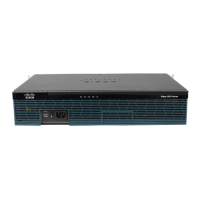C-25
Cisco 3900 Series, Cisco 2900 Series, and Cisco 1900 Series Integrated Services Routers Generation 2 Software Configuration Guide
Appendix C Using ROM Monitor
How to Use the ROM Monitor—Typical Tasks
rommon 4 > meminfo -l
The following 64 bit memory configs are supported:
-------------------------------------------------
Onboard SDRAM DIMM SOCKET 0 TOTAL MEMORY
Bank 0 Bank1 Bank 0 Bank 1
------------- ------------- ------------
128 MB 0 MB 0 MB 0 MB 128 MB
128 MB 0 MB 64 MB 0 MB 192 MB
128 MB 0 MB 64 MB 64 MB 256 MB
128 MB 0 MB 128 MB 0 MB 256 MB
128 MB 0 MB 128 MB 128 MB 384 MB
128 MB 0 MB 256 MB 0 MB 384 MB
Troubleshooting Tips
See the following tech notes:
• Troubleshooting Router Crashes
• Understanding Software-forced Crashes
• Troubleshooting Router Hangs
Exiting ROM Monitor Mode
This section describes how to exit ROM monitor mode and enter the Cisco IOS command-line interface
(CLI). The method that you use to exit ROM monitor mode depends on how your router entered ROM
monitor mode:
• If you reload the router and enter the Break key sequence to enter ROM monitor mode when the
router would otherwise have booted the system image, you can exit ROM monitor mode by doing
either of the following:
–
Enter the i command or the reset command, which restarts the booting process and loads the
system image.
–
Enter the cont command, which continues the booting process and loads the system image.
• If your router entered ROM monitor mode because it could not locate and load the system image,
perform the steps in the following procedure.
SUMMARY STEPS
1. dir flash0:[directory]
2. boot flash0:[directory] [filename]
or
boot filename tftpserver
or
boot [filename]

